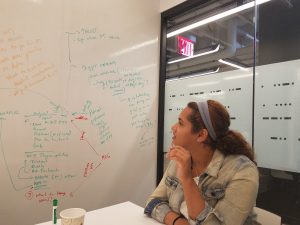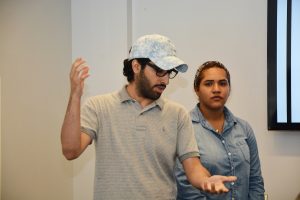Meshal Alhathal (Tandon ‘16) is the co-founder and CEO of MEG Cura, a patient compliance and reporting solution for physical therapists that improves treatment outcomes and decreases administrative costs. Meshal graduated with honors from NYU with a major in Electrical Engineering and minor in Finance. He worked at the NYU WIRELESS center; which addresses many aspects of 5G technologies. Meshal was eager to merge engineering innovations into medicine, which led him to found MEG Cura Inc.
This post is part of the NYU Summer Launchpad blog series featuring NYU entrepreneurs’ first-hand accounts of challenges faced in starting a business and the lessons learned along the way. Learn more about the NYU Summer Launchpad 2016 participants here.
A Second Look at Value Propositions: Who, How and Why
When you are attached and committed to your startup, it is hard to listen to someone who says that your idea is not good enough, or that people may not reach their pockets to buy your product. It meant that you have a product but with no way to sell it. Fortunately, in many cases, there are ways to change your product from a “nice to have” to a “must have" and build a business. While the means to make this change is unique to each business, it is crucial to gain intelligence on your product from your team, your customers, and your mentors.
The most critical of them is your customers’ feedback. They have the power to approve or ignore your product in the market. Listening and learning from your customers is vital to building your product. Here's Meg-Cura's journey of testing our value propositions and getting to product-market fit.
 Test your hypotheses
Test your hypotheses
The first day at the NYU Summer Launchpad (SLP) accelerator was a pool of information. The coaches told us to stop developing our technology and spending our nights in the lab. Instead, they asked us to study our product market and determine our initial customers. We had many assumptions built in to our business model and we needed to verify them. Thankfully, we were ready to test these hypotheses on the third day of the program. We went to our initial interviews with these guidelines in mind: never make the interview a sales pitch for our product, ask open-ended questions, and allow the interviewee to share their insights without bias.
Interviewing is Only a Step in Understanding Your Customer
After several day of interviews, I had long discussions with my co-founder, Maryam Alkhaldi. These discussions started with analyzing the data we collected in order to validate or invalidate our hypotheses. In addition, if we made a new discovery that would become a new hypothesis we tested the following week. These steps helped us prepare for the weekly presentation with our coaches and test our product's value propositions. The real-time feedback we got from coaches and cohorts was extremely helpful to set a strong basis to our data interpretation.
Your Business Model is Not Written in Stone
I am very grateful for the “Get Out The Building” methodology that SLP encouraged us to explore. I was surprised by the amount of data we were getting in the first few weeks, and this data showed us that our target customer would not be happy with the value propositions we initially presented with our product.
A Major Pivot
By actively listening to our customers and not being afraid to invalidate our initial hypotheses, we made a major pivot during the third week of the accelerator. If we had not made the decision to pivot, we would have been building a product–a medical device–that our customers did not find useful or did not care enough to pay.
Get to Know Your Customer
It was a tough start to interview medical professionals since many of the topics required solid medical knowledge. On top of preparing for questions, we started to familiarize ourselves with medical terminology that was relevant to our research. We started to study the existing economic and governmental policies that apply to the work of our interviewees.
 No One knows Your Startup More Than You Do
No One knows Your Startup More Than You Do
Being an entrepreneur gave me the responsibility to seek answers to building my product. After spending days and nights in research and customer interviews, I started to form a good understanding of my target market and had answers to questions that related to my customers, such as “what are my customers’ pain points.” Currently, I am in the process of answering questions such as “when should we launch, how much does my product cost, and how many employees or co-founders do I need? etc.”
Engineering Your Communications Skill
Coming from an engineering labs to the SLP accelerator was an interesting shift. I used to deal with circuits, oscilloscopes, and micro controllers. I soon realized that to put my electronics work into the customers’ hands, my engineering expertise must be coupled with people skills. Now, I enjoy talking about my startup and have good conversations with my customers.
Take Ten Jobs At Once
One of the challenges/blessings that often face entrepreneurs is to be able to fulfill the tasks of ten (future) employees. As soon as I decided to start my startup, I had to wear multiple hats and had become the head of engineering, marketing, public relations, etc.
As much as it is challenging to hold many responsibilities across different disciplines, it might be inevitable due to budget and resource constraints. The key is to not focus on your startup. In-order to become successful in multi-disciplined management, it is advantageous to get a basic understanding of these sectors and keep an open mind to learn and adapt as you grow.
And, as soon as you are able to, delegate responsibilities to your co-founder or trusted new-hire, so you can focus on your company's growth.







